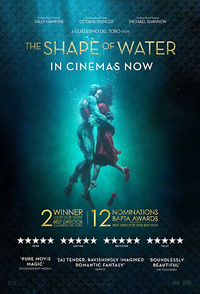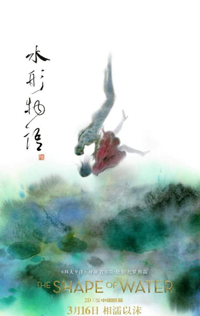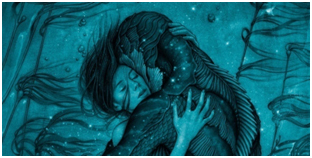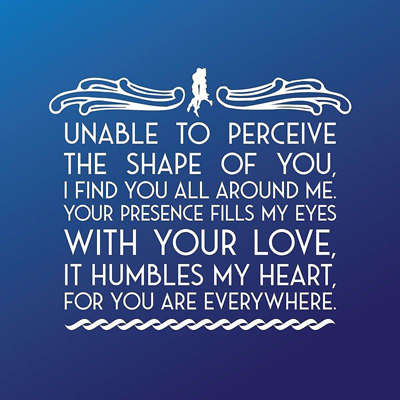
“The shape of water”, a fable about how to “shape” our lives by facing things like intolerance, rejection of difference, or fear.
When one tries to understand a movie, perhaps reading reviews online is not the best idea. That if it is an adult version of Beauty and the Beast, that if it is a story of exaltation of love, that if zoophilia. It might be that some of the theories might make some sense, but I haven’t read so much variety of … “theories” … on the same subject in a long time.
I was wondering right at the end of the film two things, the why of this title, and what sense the initial images had with the submerged floor if at any time a disaster or anything like that occurs.
The film is a fable, yes, full of symbolism and metaphors everywhere, where love serves as a leitmotif, but my first impression is that, more than love, it is about things like intolerance, rejection of the difference, the fear, and the inability to face this world,… or perhaps partly the other way around, of how we can face it and give “Shape” to our lives.
The protagonist, Eliza, “a princess who can’t speak” as the narrator defines her at the beginning of the film, is someone who is humble, low-class, sensitive, intelligent and alone. Alone to the point that she is an orphan. That he cannot speak, but this doesn’t mean she cannot communicate. Her silence is a good metaphor for her inability to make herself felt in a society that does not take her into account, neither her nor most of those around her.
Sensitive, who enjoys music and dance, who has built his life on a fantastic world in which he leans, and who supports him, in fact he lives right on top of cinema, and the only time we feel his voice, singing, is when the day comes when he has to release the “monster” and, as a farewell, he imagines himself dancing with him, as in a classical musical.

The only people she interacts with are on the one hand Giles, her neighbor: gay, sensitive like her, who paints and enjoys music and dancing with her in front of the TV or in the movies.
A man full of contradictions, with the waiter, defends blacks who are not allowed to be in the cafeteria bar, but when scenes of racist riots come out on TV, he refuses to see them, refusing to accept reality of the world around him. That he begs for his orders from the company from which he has been fired, and that despite living with two cats at one point he tells Eliza to despise the “monster”: “look, he’s not even human.” (to which she, in sign language, replies, “If we don’t do something, neither do we”) and who, attracted by the waiter, swells to buy cakes, which he stores, unable to eat the bad ones they are.
His reasons for finally helping Eliza save him are not the monster itself, but Eliza. It helps her because in the end Giles becomes aware of two things: how important she is to him. (“You’re the only person I can talk to”), and how important the monster is to her.
The other important person for Elisa, is her co-worker, Zelda, black, that is, also a second-class citizen.
He, the “monster”, (Yacuruna, water man), a strange, amphibious being, considered a god in his world, someone who there, free, has all the power. He needs water, the source of life, to live. Water that when falling from the sky will allow its release. And that in a way it is a symbol of life itself, powerful, and fragile at the same time. One of the first things Eliza does with the “monster” is share her food, and she doesn’t offer him an apple or cookies, but an egg, (another symbol of life and fertility). And also, bring your records so you can feel his music sharing with him emotions, feelings.
It is intuited at the end of the film, when she regenerates herself completely and develops her gills, that she has always already had something of him inside her, something she had to develop.

She feels good in the water, with the water. (Water = life?). From the beginning her daily routine begins with enjoying her bathtubs, and it is in the water where she releases and lives her sexuality, first alone, then with the monster, without sordidness, without guilt, without false eroticism,… with naturalness, as one more part of life. A life with which he commits himself and for which he fights. “It gets wet” literally.
In the lab, the only one who feels hurt and collaborates to free the monster is a scientist, a Russian spy, a stranger to both societies, who values him, who wants to investigate him and who does not want to be destroyed, although be it simply because of how extraordinary it is. He is the only one in the lab who wants to save him. He approaches the monster rationally, and studies it, but does not make it his own, shares nothing with it, his interest is cold, intellectual, perhaps “wet” to save him, but he does not “submerges”, as does Eliza, or even Giles, who eventually empathizes with him, and on several occasions is touched by him letting him put his hand on his head, and when he accepts also begins to regenerate -se (her hair grows back). Without impregnating himself with “life,” the spy, only with his scientific interest, as a mere observer of “life,” is not enough,… and in the end also dies.
La cThe political charge is still present throughout the film. It seems to be a common thing in Guillermo del Toro, and leaves no right cane. References to racism, the Cold War, Americans and Russians, fighting for opposite ideals but with the same values and methods. The American dream, symbolized in the Cadillac, (“what will be the future”) and which ends up drowned during the escape of the monster.
The portrait of American society, symbolized by the head of laboratory safety, who aspires to go to a better place at all costs and at all costs, with a “model” family (also worthy of study) interest in the “monster” he is purely instrumental in ascending in his career. An unscrupulous sadist to achieve his purposes by humiliating and despising all those around him and those below him, a representative of a society that is slowly rotting symbolized on his own fingers.
“We are created in the image and likeness of the Lord. And you won’t believe that “this” is what the Lord looks like, right? ”,“ We don’t need to learn. We need Americans… not to learn, ”forceful statements of principles about the concept and value society places on religion and education.
In the end, however, in the conversation with the general, it is clear that he is nothing more than a poor devil, an instrument of a system that will reward him as long as he is useful, but that if he fails, he will not forgive his mistakes and set him aside. . Like the Russians, who use their collaborators equally and despise life equally.
The family is also criticized. Starting with the one of the head of security, and then in a lot of details, like when the waiter tells Giles to make him out of the bar “here come families,” or like Zelda, having to lie about the escape from the monster, who tells Elisa, “I don’t know how to lie, except Brewster (her husband), you have to lie to have a marriage.”.
References to the “goodness” of the law are equally compelling. First Giles’ responses to the idea of saving the monster: “You can’t do it because it’s against the law!” – “Probably just talking about it is illegal,” or that of Zelda’s husband when she wants to warn Eliza that they’re going for her “You won’t warn her !, she broke the law.” I can’t help but think of Montesquieu (“Something is not fair because it is law, it must be law because it is just”), or Gandhi (“When a law is unjust, the right thing is to disobey”). It seems that, as the Catalan independence activists think, Del Toro also thinks that certain laws are overrated.
There are two quotes we can get to see from the calendar sheets that Elisa pulls out: one is, “Time is but a flowing river of our past.” At one point, when asking Giles for help, Eliza tells him “Everything I am, everything I’ve always been, has brought me here, to him.”
“We are” the fruit of our past. We need to accept our past and accept ourselves,… And vindicate who we are.
“When he looks at me the way he looks at me, he doesn’t know what I’m missing, nor does he think it’s incomplete, he sees me as I am, what I am.” Sometimes we tend to feel incomplete because we don’t satisfy all the expectations that society imposes on us, and we need someone, from outside, to remind us of our worth.
The other is, “Life is the wreck of our plans,”… (Woody Allen put it by saying, “If you want to make God laugh, tell him your plans.”), We’re a little back in the ” To be or not to be “, in a way to accept, although perhaps it is to accept that it is necessary to fight, (acceptance does not mean resignation), because nothing happens as it has been planned. There’s a Hindu proverb that says something like “in the end everything will turn out well and if it doesn’t turn out well it’s not the end yet”, although it doesn’t give clues on how to expect it to come to an end.
Water has no shape, the shape of water is configured by what it contains, and by its own container,…. WE are the form of water, the ones who shape water, and we are the ones who have to submerge, evolve, and die and rise to shape ourselves,…. it is our responsibility, and we may come to regenerate or die in the attempt. (Trusting that it doesn’t happen to us like Zelda’s husband, and that even if a hundred years pass we won’t be able to understand anything).
As I finish, two quotes come to my mind, one from Jack Kerouac: “What you feel will end up finding its own form” and the other from Bruce Lee:
“Empty your mind, be formless, shapeless, like water,now you put water into a cup it becomes the cup you put water into a bottle it becomes the bottle you’re putting and it will be the bottle, you’re putting in a teapot it becomes the teapot. Water can flow,… or it can crash.
Be water my friend.”
and I want say goodbye with the poem Guillermo chose as his farewell in the filme:

